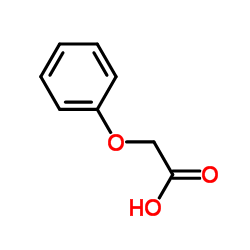苯氧乙酸

苯氧乙酸结构式

|
常用名 | 苯氧乙酸 | 英文名 | Phenoxyacetic acid |
|---|---|---|---|---|
| CAS号 | 122-59-8 | 分子量 | 152.147 | |
| 密度 | 1.2±0.1 g/cm3 | 沸点 | 285.0±0.0 °C at 760 mmHg | |
| 分子式 | C8H8O3 | 熔点 | 98-100 °C(lit.) | |
| MSDS | 中文版 美版 | 闪点 | 115.1±13.3 °C | |
| 符号 |

GHS07 |
信号词 | Warning |
|
Synthesis, characterization and antibacterial activity of azomethine derivatives derived from 2-formylphenoxyacetic acid.
Molecules 12(2) , 245-54, (2007) A series of eight new azomethine derivatives were synthesized by reacting 2-formylphenoxyacetic acid with aromatic amines. The chemical structures of these compounds were confirmed by means of 1H-NMR, 13C-NMR, MS and elemental analysis. The compounds were ass... |
|
|
Penicillin V acylase from Pectobacterium atrosepticum exhibits high specific activity and unique kinetics.
Int. J. Biol. Macromol. 79 , 1-7, (2015) Penicillin V acylases (PVAs, E.C.3.5.11) belong to the Ntn hydrolase super family of enzymes that catalyze the deacylation of the side chain from phenoxymethyl penicillin (penicillin V). Penicillin acylases find use in the pharmaceutical industry for the prod... |
|
|
Correlations between chromatographic parameters and bioactivity predictors of potential herbicides.
J. Chromatogr. Sci. 52 , 676-84, (2014) Different liquid chromatography techniques, including reversed-phase liquid chromatography on Purosphere RP-18e, IAM.PC.DD2 and Cosmosil Cholester columns and micellar liqud chromatography with a Purosphere RP-8e column and using buffered sodium dodecyl sulfa... |
|
|
Development of a physiologically-based pharmacokinetic model of 2-phenoxyethanol and its metabolite phenoxyacetic acid in rats and humans to address toxicokinetic uncertainty in risk assessment.
Regul Toxicol Pharmacol 73 , 530-43, (2015) 2-Phenoxyethanol (PhE) has been shown to induce hepatotoxicity, renal toxicity, and hemolysis at dosages ≥ 400 mg/kg/day in subchronic and chronic studies in multiple species. To reduce uncertainty associated with interspecies extrapolations and to evaluate t... |
|
|
Characterization of 2,4-dichlorophenoxyacetic acid and 2,4,5-trichlorophenoxyacetic acid-degrading fungi in Vietnamese soils.
FEMS Microbiol. Ecol. 84(1) , 124-32, (2013) Sixty-nine fungal strains were isolated countrywide from 10 Vietnamese soils, in areas both with and without a history of exposure to Agent Orange, and their degrading activities on the phenoxy acid herbicides 2,4-dichlorophenoxyacetic acid (2,4-D) and 2,4,5-... |
|
|
Decrease of intracellular pH as possible mechanism of embryotoxicity of glycol ether alkoxyacetic acid metabolites.
Toxicol. Appl. Pharmacol. 245(2) , 236-43, (2010) Embryotoxicity of glycol ethers is caused by their alkoxyacetic acid metabolites, but the mechanism underlying the embryotoxicity of these acid metabolites is so far not known. The present study investigates a possible mechanism underlying the embryotoxicity ... |
|
|
Discovery of carboranes as inducers of 20S proteasome activity.
ChemMedChem 5(8) , 1236-41, (2010)
|
|
|
Retention behavior of phenoxyacetic herbicides on a molecularly imprinted polymer with phenoxyacetic acid as a dummy template molecule.
Bioorg. Med. Chem. 15(18) , 6089-95, (2007) Molecular imprinted polymers (MIPs) binding with phenoxyacetic acid (PA) as a dummy template molecule were synthesized via thermal initiation in aqueous medium. The retention behaviors of benzoic acid (BA), PA, 2-methyl-4-chlorophenoxyacetic acid (MCPA), 4-ch... |
|
|
Switching between agonists and antagonists at CRTh2 in a series of highly potent and selective biaryl phenoxyacetic acids
Bioorg. Med. Chem. Lett. 21(12) , 3616-21, (2011) A novel series of biaryl phenoxyacetic acids was discovered as potent, selective antagonists of the chemoattractant receptor-homologous expressed on Th2 lymphocytes receptor (CRTh2 or DP2). A hit compound 4 was discovered from high throughput screening. Modul... |
|
|
Antidotes to anthrax lethal factor intoxication. Part 3: Evaluation of core structures and further modifications to the C2-side chain.
Bioorg. Med. Chem. Lett. 22(6) , 2242-6, (2012) Four core structures capable of providing sub-nanomolar inhibitors of anthrax lethal factor (LF) were evaluated by comparing the potential for toxicity, physicochemical properties, in vitro ADME profiles, and relative efficacy in a rat lethal toxin (LT) model... |